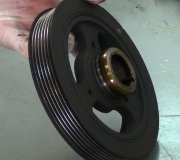I agree that does sound strange, but I've seen some really weird stuff on my own vehicle the last two weeks. I'm going to research your engine because I couldn't remember if it was an interference engine, but in the meantime I can share some information about the four cylinder engine.
They use a crankshaft position sensor on the back of the engine and a camshaft position sensor on the driver's side of the cylinder head. The crankshaft and camshaft are the two parts that must be in perfect unison to prevent the valves from hitting the pistons. If something happens that causes the cogged timing belt to jump one tooth, the Engine Computer will see the two signals from those two sensors arriving at different times. It will set a diagnostic fault code, "cam and crank sync" in memory and turn on the Check Engine light. Horsepower will suffer but you might not notice it so much at highway speeds.
If the timing belt jumps two teeth, the computer shuts the engine down by turning off the power feeding the injectors, fuel pump, and ignition coil(s) / spark plugs. It does that to protect the valves. If the belt jumps three teeth, ... Well, that's when the bad stuff happens. I would be more inclined to think it was a piece of timing belt that was knocking but it's impossible to say when I can't see it. The fact that it's been replaced already suggests I'm wrong, but regardless, if something got in there and made noise, that proves the engine was running, and if it was running, the computer hadn't shut it down, and that means the timing belt could have only been off a maximum of one tooth, if even that much, and that means the valves should not have been damaged.
I CAN suggest that sometimes you don't get a straight answer from the mechanic, especially if you're in a bigger shop where translation is lost between the mechanic who knows what is wrong and the service adviser who isn't a mechanic but understands how to talk with customers. The miscommunication is not intentional, rather, they "dumb-it-down" so customers can understand it, but then they sometimes get caught in what appears to be a lie or deception when the customer actually knows more about cars and how they work. Here in my town we are very lucky to have a whole bunch of very reputable shops, but we have a few rip-off artists too. Everyone in the repair industry knows which ones those shops are, but a lot of people think they're the best places to go because the lies they were told didn't sound like lies. One way to spot a reputable shop is the people there will rarely speak negatively about a competitor.
Getting back to your engine, the camshaft position sensor is inside the distributor, and the distributor is driven by the camshaft, so the computer will still detect signals that are out-of-sync. One of the things every mechanic dreads is new problems that show up while the car is in his possession. There really isn't an easy way for the mechanic to CAUSE the problem he said he found, in fact, it would take a real lot of work to damage something, even intentionally, so I have to think this problem was going to happen anyway. That doesn't make it any easier to accept, but I agree it does sound fishy.
By the way, there are two models of Sebring. Do you have the convertible model which is a twin to the Stratus and Cirrus, or the LXI model which is a twin to the Dodge Avenger? The radio display is orange on the LXI model. I think they use the standard bluish-green display on the domestic model.
Caradiodoc
Monday, October 25th, 2010 AT 3:30 AM


